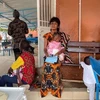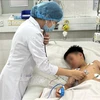Hanoi (VNA) – The number of people living with HIV/AIDS in Hanoi stood at 20,666 as of October 31, ranking second nationwide and making up 10 percent of the country’s total cases.
Notably, 30 percent of these people are undiagnosed, while many have yet to take life-saving antiretroviral (ARV) therapy or have given up the ARV treatment, according to the city’s centre for disease control.
Hanoi has taken various steps to prevent the increasing rate of HIV infections. The city has expanded its provision of methadone treatment for drug users at 18 health care facilities and given away condoms and injection needles to high-risk people across all districts.
However, according to the Hanoi Department of Health, the effectiveness of local prevention efforts remains low as the pattern of HIV infection is complicated and changing. The prevalence of HIV transmission through blood in Hanoi dropped, but sexually-transmitted infections rose this year. The number of new HIV infections among gay men increased sharply, from 1.1 percent in 2015 to 24.8 percent in 2018.
Many people living with HIV/AIDS refuse HIV testing and treatment due to fear of being discriminated by society. It is one of the main causes behind the low rate of new HIV infections being detected and of HIV-positive people joining ARV treatment.
Funding cuts and lack of personnel and facilities for HIV/AIDS control and prevention has also contributed to the problems.
According to the Ministry of Health, about 50,000 people living with HIV in Vietnam remain unidentified. Some 209,000 HIV-affected people are recorded in the country, however only 175,000 are seeking or undergoing treatment. Only 130,000 patients receive sustainable ARV treatment.
In the first six months of 2018, 3,500 new cases of HIV infection were found, more than 1,800 of which developed into AIDS. A total of 814 HIV-positive people died during this period.
Compared to the same period last year, the number of new HIV infections, new AIDS patients, and deaths from HIV-related illnesses decreased by 30 percent, 27 percent, and 2 percent, respectively.
The percentage of HIV infected people among drug abusers and sex workers rose from 7.36 percent in 2017 to 12.2 percent in 2018. The lack of support for these vulnerable groups has meant that the disease has been hard to control across this demographic. –VNA
Notably, 30 percent of these people are undiagnosed, while many have yet to take life-saving antiretroviral (ARV) therapy or have given up the ARV treatment, according to the city’s centre for disease control.
Hanoi has taken various steps to prevent the increasing rate of HIV infections. The city has expanded its provision of methadone treatment for drug users at 18 health care facilities and given away condoms and injection needles to high-risk people across all districts.
However, according to the Hanoi Department of Health, the effectiveness of local prevention efforts remains low as the pattern of HIV infection is complicated and changing. The prevalence of HIV transmission through blood in Hanoi dropped, but sexually-transmitted infections rose this year. The number of new HIV infections among gay men increased sharply, from 1.1 percent in 2015 to 24.8 percent in 2018.
Many people living with HIV/AIDS refuse HIV testing and treatment due to fear of being discriminated by society. It is one of the main causes behind the low rate of new HIV infections being detected and of HIV-positive people joining ARV treatment.
Funding cuts and lack of personnel and facilities for HIV/AIDS control and prevention has also contributed to the problems.
According to the Ministry of Health, about 50,000 people living with HIV in Vietnam remain unidentified. Some 209,000 HIV-affected people are recorded in the country, however only 175,000 are seeking or undergoing treatment. Only 130,000 patients receive sustainable ARV treatment.
In the first six months of 2018, 3,500 new cases of HIV infection were found, more than 1,800 of which developed into AIDS. A total of 814 HIV-positive people died during this period.
Compared to the same period last year, the number of new HIV infections, new AIDS patients, and deaths from HIV-related illnesses decreased by 30 percent, 27 percent, and 2 percent, respectively.
The percentage of HIV infected people among drug abusers and sex workers rose from 7.36 percent in 2017 to 12.2 percent in 2018. The lack of support for these vulnerable groups has meant that the disease has been hard to control across this demographic. –VNA
VNA
























